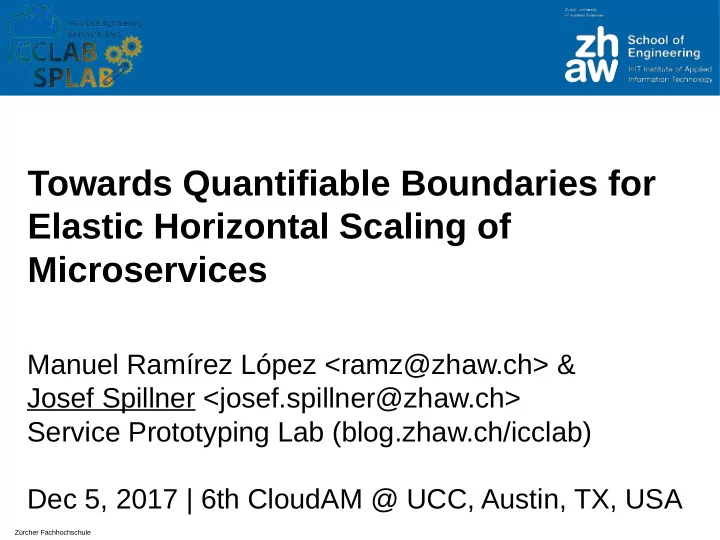

Towards Quantifiable Boundaries for Elastic Horizontal Scaling of Microservices Manuel Ramírez López <ramz@zhaw.ch> & Josef Spillner <josef.spillner@zhaw.ch> Service Prototyping Lab (blog.zhaw.ch/icclab) Dec 5, 2017 | 6th CloudAM @ UCC, Austin, TX, USA Zürcher Fachhochschule
Motivation Application... ... scaling: accomodate more users / growing workload desired: elasticity, rapidity ... auto-scaling: rule-based scaling actions ↹ trade-offs: effort for rule definition, initial calibration, hotspots ... pre-scaling (our work): determine initial combinatorial scaling fixed-workload vs. variable workload 2
Model Microservices composition - three classes of services 3
Model Scale cube (Abbott and Fisher, 2015) Independently deployable microservices → Y axis (Hasselbring, 2016) 4
Assumntions Application architecture following a microservice design ● stateful CRUD service ● replica count per service Scenario implementation ● online document management application ● RESTful Python service, MongoDB Scale cube relation ● X axis: horizontal replication ● Z axis: data partitions 5
Assumntions Nonlinear constrained horizontal scaling behaviour on X axis according to following graph 6
Research Question and Annroach Question: »Can the best combination of replicas for a given application and workload be calculated for performance-critical and cost-constrained settings?« x x application workload optimality Approach: ● Formalisation of application structure, task, workload, environment + scaling constraints ● Combinations of scaling factors, optimal result vectors 7
Method: Ontimality What is the “best“ combination? TG: Type graph IG: Instance graph - replicas per microservice - 3x IG O 8
Method: Formalisation Mathematical model: m-dimensional makespan matrix (2 out of m dimensions shown conforming scenario) where: ● m - # of microservices ● n - # of replicas per microservice ● stateful services: partitioning scheme (e.g. per tenant) ● e - experiment (task/workload combination) ● µ - makespan 9
Method: Ontimal Factors Formula Three approaches ● unconstrained (baseline) ● constrained ● relaxed-constrained (with rate) cost: resource cost or monetary cost I: set of indices of M 10
Method: Comnlexity Reduction Sparse matrices/arrays due to not fully connected microservices (TG level) ● representation: bi-directional disconnected graph ● vertices = microservices ● edges = connections (communication links) Transformation: set of fully connected graphs (caveat: not validated, relates to patterns - e.g. sidecar) 11
Imnlementation: Factor Injection Integration with microservice management platforms ● e.g. container schedulers (Docker Compose, Kubernetes, ...) ● using placeholders in composition templates Example as used in experiment: Kubernetes 1.5 deployment @ Google Cloud Platform (GCP - GCE) { "kind": "Deployment", "apiVersion": "extensions/v1beta1", "metadata": { "name": "MICROSERVICE", }, "spec": { "replicas": REPLICAS, "spec": { "containers": [ { "name": "MICROSERVICEIMPL", "image": "NAMESPACE/CONTAINER:1.1", ... 12
Imnlementation: Factor Injection Verification through graphical user interface 13
Results Stateless microservice: “arkisdocument“, API to search in documents ● from 1 to 11 replicas Stateful microservice “mongodb“, 300 documents per tenant ● from 1 to 2 replicas Workload generator/test microservice, not managed, not scaled Cost/performance ratio is not linear. 14
Outlook: Variable Workloads K experiments with maximum fulfilment of cost/performance requirements Intersection analysis 15
Summary Contributions ● formalised application scaling determination (X + Z axes in scale cube with microservice composition as Y axis) ● testbed based on Docker containers in Kubernetes ● practical use to complement autoscaling ● scientific open notebook for future work https://github.com/serviceprototypinglab/scalability-experiments Recent related work: «ThrottleBot - Performance without Insight» by Chang, Panda, Tsai, Wang, Shenker (arXiv:1711.00618) «Microservices for Scalability» by Wilhelm Hasselbring, ICPE‘16 keynote 16
Recommend
More recommend